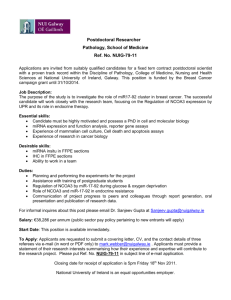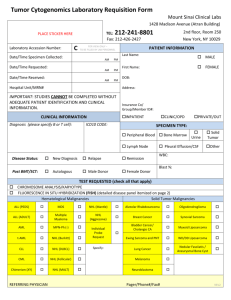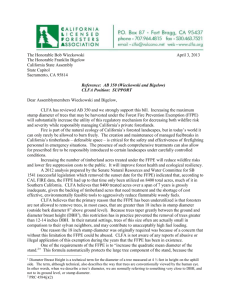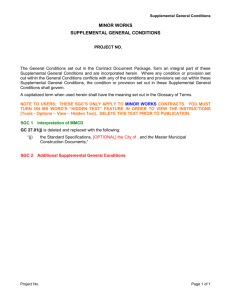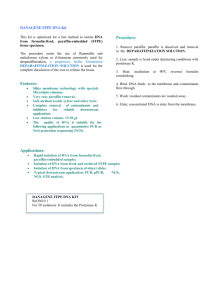Supplemental Material
advertisement
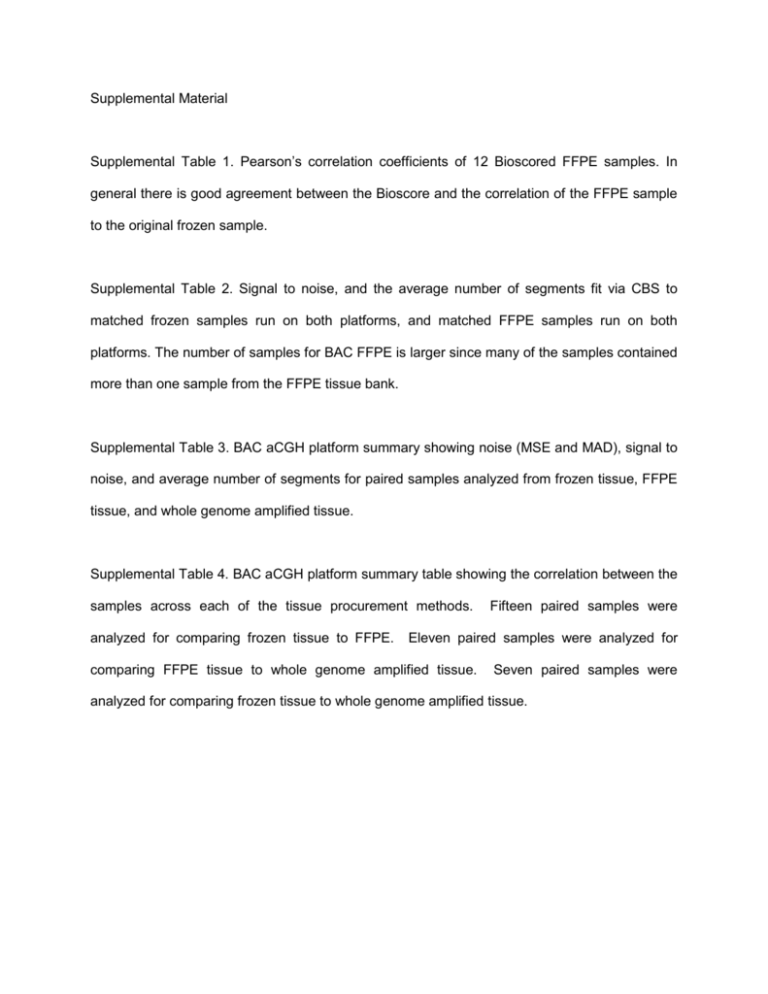
Supplemental Material Supplemental Table 1. Pearson’s correlation coefficients of 12 Bioscored FFPE samples. In general there is good agreement between the Bioscore and the correlation of the FFPE sample to the original frozen sample. Supplemental Table 2. Signal to noise, and the average number of segments fit via CBS to matched frozen samples run on both platforms, and matched FFPE samples run on both platforms. The number of samples for BAC FFPE is larger since many of the samples contained more than one sample from the FFPE tissue bank. Supplemental Table 3. BAC aCGH platform summary showing noise (MSE and MAD), signal to noise, and average number of segments for paired samples analyzed from frozen tissue, FFPE tissue, and whole genome amplified tissue. Supplemental Table 4. BAC aCGH platform summary table showing the correlation between the samples across each of the tissue procurement methods. analyzed for comparing frozen tissue to FFPE. Fifteen paired samples were Eleven paired samples were analyzed for comparing FFPE tissue to whole genome amplified tissue. Seven paired samples were analyzed for comparing frozen tissue to whole genome amplified tissue. Supplemental Table 1 Bioscore 1.3 1.6 1.9 2.7 3.1 9.6 13.5 13.9 16.4 20.2 21 22 Pearson's Correlation 0.68 0.46 0.56 0.80 0.70 0.90 0.81 0.48 0.78 0.82 0.73 0.92 Supplemental Table 2 CGH platform/ DNA source BAC/Frozen Agilent/Frozen BAC/FFPE Agilent/FFPE # of Signal to Noise samples 6 8.051 6 4.186 16 7.796 10 3.256 Avg # of Segments 104.43 132.43 175.19 515.30 Supplemental Table 3 DNA source BAC/Frozen BAC/FFPE BAC/WGA # of MAD Samples 59 .053 24 .083 13 .110 MSE .010 .028 .058 Signal Noise 6.946 5.555 4.556 to Avg. # of segments 101.63 144.87 121.39 Supplemental Table 4 Pearson: log2 T/C Pearson: segment Spearman: log2 T/C Spearman: segment Frozen : FFPE .51 .66 .43 .62 FFPE:WGA .75 .78 .65 .72 Frozen:WGA .36 .56 .26 .50 2 Supplemental Figure 1. Isolation of individual Hodgkin Reed-Sternberg (HRS) cells using laser capture microdissection. Samples were mounted on PALM membrane slides (PEN-membrane; Zeiss) and stained for CD30 (brown) and hematoxylin-eosin counterstained. A) CD30 IHC on FFPE HD patient sample, 63x on PALM microlaser. Arrows denote rare Hodgkin Reed-Sternberg cells. B) On the PALM microdissection workstation, cells of interest (i) were designated (ii) for laser (UV-A) trace (iii) and isolated by UV-A pulse catapult (iv) into a microfuge cap containing TE buffer. Supplemental Figure 2. Confirmation of aCGH CNAs by FISH for NEDD9 and WISP3 on chromosome 6. Top panel: The aCGH profile for chromosome 6, RP11-28L24 is circled in red. Middle panel: The probes RP11-28L24 (WISP3; 6q21; green signal) and RP11-679B17 (NEDD9; 6p24.1; red signal) were used to assess copy number, l to r: interphase nucleus with 6 green (WISP3) and 4 red (NEDD9) signals; metaphase with same signal pattern; DAPI-banded image of same metaphase showing the deleted 6 chromosomes (hybridize to the green probe only). These two derivative chromosomes are der(6)del(6)(p12.3)del(6)q14.3), were confirmed by 24-color karyotyping (lower panel), tinted fluorophore image, left, and blended fluorophore image at right, both showing 4 copies of chromosome 6 and two copies of the der(6). Supplemental Figure 3. Whole genome aCGH profile of a frozen sample analyzed in parallel using BAC aCGH (top) and Agilent aCGH (bottom). CBS segmentation values are in red, preprocessed log2 probe values are in grey. Supplemental Figure 4. Whole genome aCGH profile of an FFPE sample analyzed in parallel using BAC aCGH (top) and Agilent aCGH (bottom). CBS segmentation values are in red, preprocessed log2 probe values are in grey. Note this is a different sample than analyzed in Figure 3. 3 4
